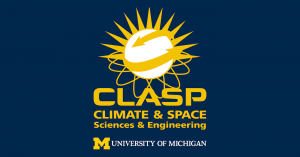Presented By: Climate and Space Sciences and Engineering
CLaSP Seminar Series - Prof. David Southwood

Our guest for this week's CLaSP Seminar Series will be Prof. David Southwood of Imperial College London. Please join us!
Title: "Why Saturn’s magnetic field pulses: certainties, probabilities, possibilities"
Abstract: Regular magnetic oscillations with slightly separate periods for northern and southern hemispheres permeate Saturn’s magnetosphere. Much is known of them but an established consensus on their precise origin or whether they play a fundamental role in magnetospheric dynamics has been hard to reach. Magnetohydrodynamics (MHD) should apply and we will apply some simple ideas from MHD. However, we start from signal characteristics established from the 13 years of Cassini observations. Symmetry arguments can help. Indeed, when northern and southern periods matched for around a year in 2013-14, we argue that the symmetry seen reveals a lot. Using these results with early MHD theory (from the 80s), in this special case one can show that the transverse field components have equatorial nodes and so that the equatorial (torus) plasma executes large (Rs) gyrations always in the same sense. A subtler deduction is that energy absorption or mode conversion near the equator is unavoidable. Estimating gyration amplitude suggests steady substantial angular momentum transfer is likely. Indeed, re-examining data on both steady and oscillatory electrical currents with this in mind reveals that the oscillations are likely to be the major means of ionosphere-magnetosphere angular momentum transfer in the middle magnetosphere. Energy principle arguments add to the credibility of the latter idea. Finally, we speculate on the gyrations role in radial transport.
David Southwood is planetary scientist with primary interest in magnetism and magnetohydrodynamics. Currently a Senior Research Investigator at Imperial College, London. He is a member of the NASA JPL Advisory Council and ESA Council, Chair of the Steering Board of the UK Space Agency, Chair of the Board of Trustees of the London Institute for Space Policy and Law and a past president of the Royal Astronomical Society. After an academic career as a space scientist at Imperial College, he joined ESA as Head of Earth Observation Strategy, drawing up for ESA what is the current architecture for European Earth Observation programmes (Earth Explorers and Copernicus). In 2001 he became Director of Science at ESA, taking responsibility for all Astronomy and Space science missions, developing Herschel, Planck and GAIA astronomical observatories, Mars Express and Venus Express and oversight of Huygens landing on Titan. He later took responsibility for developing Europe’s long term plans in Mars exploration. He returned to Imperial College in 2011.
Title: "Why Saturn’s magnetic field pulses: certainties, probabilities, possibilities"
Abstract: Regular magnetic oscillations with slightly separate periods for northern and southern hemispheres permeate Saturn’s magnetosphere. Much is known of them but an established consensus on their precise origin or whether they play a fundamental role in magnetospheric dynamics has been hard to reach. Magnetohydrodynamics (MHD) should apply and we will apply some simple ideas from MHD. However, we start from signal characteristics established from the 13 years of Cassini observations. Symmetry arguments can help. Indeed, when northern and southern periods matched for around a year in 2013-14, we argue that the symmetry seen reveals a lot. Using these results with early MHD theory (from the 80s), in this special case one can show that the transverse field components have equatorial nodes and so that the equatorial (torus) plasma executes large (Rs) gyrations always in the same sense. A subtler deduction is that energy absorption or mode conversion near the equator is unavoidable. Estimating gyration amplitude suggests steady substantial angular momentum transfer is likely. Indeed, re-examining data on both steady and oscillatory electrical currents with this in mind reveals that the oscillations are likely to be the major means of ionosphere-magnetosphere angular momentum transfer in the middle magnetosphere. Energy principle arguments add to the credibility of the latter idea. Finally, we speculate on the gyrations role in radial transport.
David Southwood is planetary scientist with primary interest in magnetism and magnetohydrodynamics. Currently a Senior Research Investigator at Imperial College, London. He is a member of the NASA JPL Advisory Council and ESA Council, Chair of the Steering Board of the UK Space Agency, Chair of the Board of Trustees of the London Institute for Space Policy and Law and a past president of the Royal Astronomical Society. After an academic career as a space scientist at Imperial College, he joined ESA as Head of Earth Observation Strategy, drawing up for ESA what is the current architecture for European Earth Observation programmes (Earth Explorers and Copernicus). In 2001 he became Director of Science at ESA, taking responsibility for all Astronomy and Space science missions, developing Herschel, Planck and GAIA astronomical observatories, Mars Express and Venus Express and oversight of Huygens landing on Titan. He later took responsibility for developing Europe’s long term plans in Mars exploration. He returned to Imperial College in 2011.